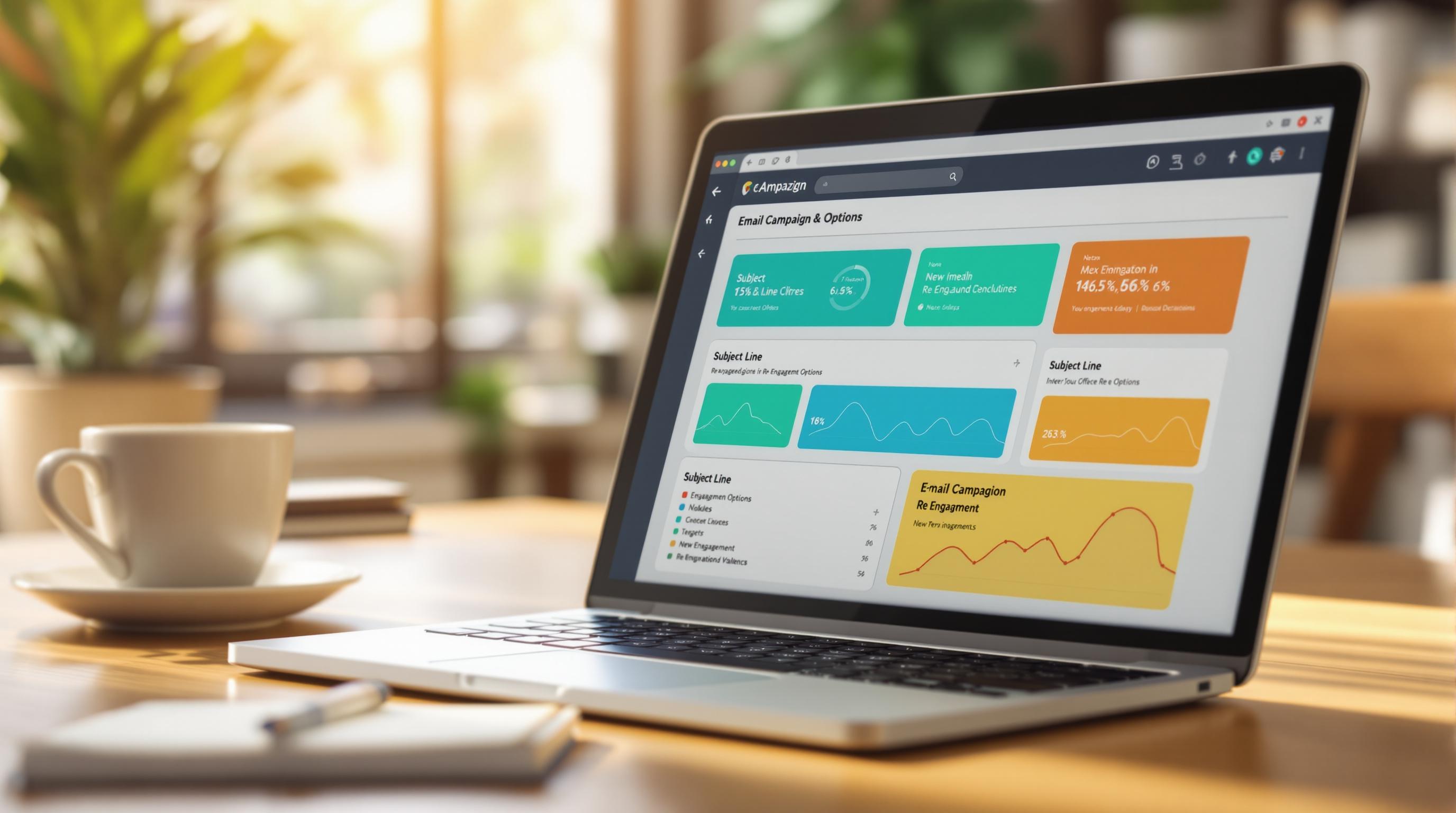Key takeaway: Personalization in email marketing isn’t optional anymore - it’s what customers expect. Businesses that personalize effectively see up to 40% more revenue and a 139% increase in click rates. However, scaling personalization while keeping costs low is a challenge.
Here’s how to solve it: Use tools that combine AI, automation, and integration to create tailored campaigns without overshooting your budget.
What to look for in a tool:
- AI-driven features: Real-time data analysis, predictive send times, and automated content creation.
- Integration: Smooth connections with CRMs and other platforms for unified customer data.
- Automation: Triggered workflows that drive 320% more revenue than manual emails.
- Analytics: Real-time tracking to measure what works and adjust quickly.
- Compliance: Built-in tools to manage unsubscribes, spam scores, and legal requirements.
Top tools to consider:
- ActiveCampaign: Combines email marketing, automation, and CRM for $39/month.
- Mailchimp: Free for small users, with paid plans starting at $13/month.
- Salesforce Marketing Cloud: Advanced AI for enterprise needs (custom pricing).
- Insider: AI-powered personalization for e-commerce (custom pricing).
- Email Service Business Directory: A resource to compare platforms based on features, pricing, and user feedback.
Why it matters: Personalized emails convert 6x better than generic ones. With the right tools, you can meet customer expectations, increase engagement, and maximize ROI - all while staying within budget.
What Are The Best Email Personalization Tools? - TheEmailToolbox.com
How to Evaluate Personalization Tools
Picking the right personalization tool is crucial for email marketing success. With 67% of consumers expressing frustration over untailored interactions, getting this decision right can significantly impact your results. The challenge? Finding tools that offer advanced features without straining your budget or technical resources.
When evaluating tools, focus on their ability to provide intelligent automation, smooth integration, and detailed analytics. These features can elevate your campaigns from basic mail-merge techniques to truly personalized experiences. Pay special attention to how these tools utilize real-time data and AI to refine personalization efforts.
Real-Time Data Processing and AI Features
Artificial intelligence is changing the game for customer engagement, offering powerful capabilities without blowing up your budget. Today's personalization tools use AI to analyze customer behavior, predict preferences, and adjust content dynamically. This goes beyond simply adding a recipient's name - it optimizes timing, content, and overall relevance.
One standout feature to look for is predictive send-time optimization. For instance, Seventh Sense uses AI to determine the best time to send emails, helping platforms like HubSpot and Marketo increase open rates by 20-40%.
AI-driven content creation is another game-changer. These tools can generate dynamic email copy, subject lines, and even images, while automated A/B testing refines campaigns by analyzing multiple variables. Real-time segmentation is also key - it automatically groups subscribers based on their most recent actions, like website visits, purchase history, or email engagement. This ensures your messages stay relevant as customer preferences shift.
But personalization isn’t just about data processing. Seamless integration with your existing systems is just as critical for long-term success.
Integration, Automation, and Growth Capacity
For sustained growth, your personalization tool must integrate effortlessly with your CRM and other systems. This creates a unified view of your customers by pulling in data from various touchpoints and feeding engagement metrics back into the system. Businesses using integrated CRM systems report a 29% boost in sales and a 34% increase in sales productivity.
Automation is another must-have. Automated workflows can trigger emails based on customer behavior or key events, generating 320% more revenue than non-automated emails while keeping operations scalable. Companies that prioritize customer data integration also see a 25% improvement in operational efficiency.
"CRM and email integration present an exciting opportunity for data activation, automation, and optimization - ultimately driving stronger customer engagement and higher conversion rates." - Jennifer Lancaster Dana, Marketing Tech Executive
Growth capacity is equally important. Your tool should be able to handle increasing email volumes, larger subscriber lists, and more complex data without losing performance. Multi-channel capabilities are a bonus, allowing you to coordinate messaging across SMS, push notifications, and other platforms for consistent personalization.
Finally, analytics and compliance features round out the list of essential evaluation criteria.
Analytics, Reporting, and Legal Compliance
Top-tier personalization tools stand out with their ability to connect email performance to actual business outcomes. They don’t just track engagement - they show you which campaigns are driving sales while helping you manage costs.
Look for real-time dashboards and behavioral tracking to fine-tune your campaigns. Features like heat maps, click tracking, and engagement scoring provide insights into what’s working and what’s not, enabling strategic adjustments.
Compliance is non-negotiable. The right tool should automatically handle unsubscribe requests, manage suppression lists, and maintain audit trails. Deliverability monitoring features, such as spam score checks and sender reputation management, ensure your emails reach inboxes. Finally, ROI tracking capabilities help you measure the impact of personalization on revenue, customer lifetime value, and campaign profitability, making it easier to justify your investment and plan future strategies.
Email Service Business Directory: Find the Right Tools
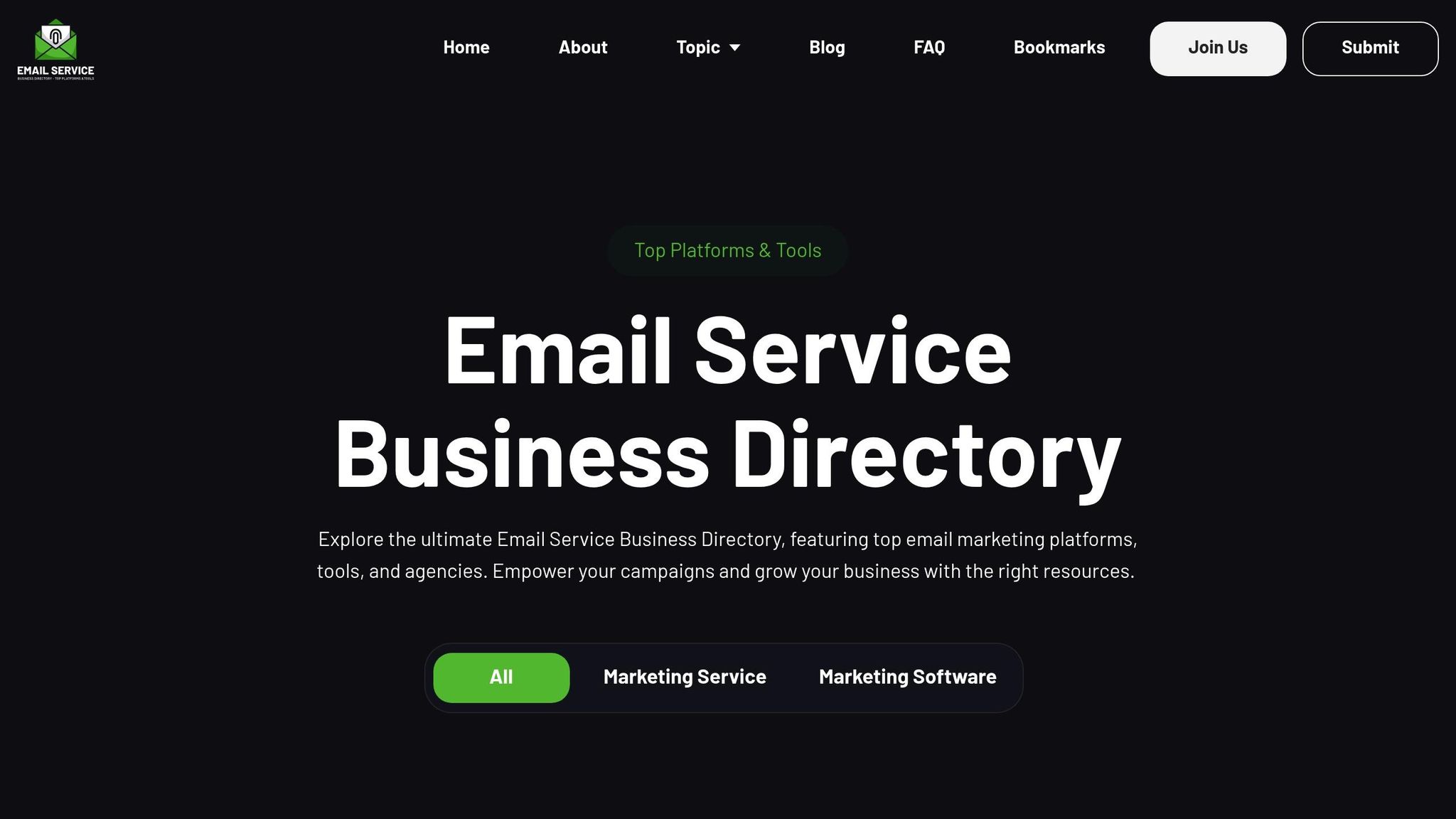
Once you've nailed down the key features you need, the next step is finding a reliable resource to sift through the many options out there. That’s where the Email Service Business Directory comes in. This curated directory is designed to help US businesses navigate the crowded field of email marketing platforms, making it easier to identify tools that align with your personalization strategy.
The directory focuses on platforms that deliver real results - whether it’s increasing sales, nurturing leads, or improving customer retention. By narrowing down the choices, it saves you time and helps you zero in on solutions tailored to your goals.
It also simplifies the process of evaluating tools that strike a balance between affordability and scalability. Considering that personalized emails drive six times more transactions, choosing the right platform is a crucial step. The directory provides detailed listings of tools with advanced AI and automation features, making personalized email campaigns more effective and efficient.
Budgeting is made easier with transparent pricing comparisons. For instance, platforms like Sendy offer email delivery for as little as $1 per 10,000 emails via Amazon SES, while traditional providers might charge $200 for the same volume. This level of clarity helps businesses plan for growth without breaking the bank.
Integration is another key focus. The directory highlights platforms that seamlessly connect with popular CRM systems, e-commerce platforms, and analytics tools. This ensures you can build a comprehensive personalization strategy without compatibility headaches.
For those without a tech-heavy background, the directory points out user-friendly options featuring intuitive interfaces and drag-and-drop editors. Before diving in, it’s important to define your personalization goals and budget. Many platforms even offer free trials, giving you a chance to test their features before committing.
To make your decision even easier, the directory includes user feedback and ratings, offering a glimpse into how each platform performs in real-world scenarios.
sbb-itb-6e7333f
Best Tools for Cost-Effective Personalization at Scale
Choosing the right email marketing platform is crucial for executing a successful personalization strategy. After reviewing numerous options, these five tools stand out for offering robust personalization features at a budget-friendly price point.
ActiveCampaign
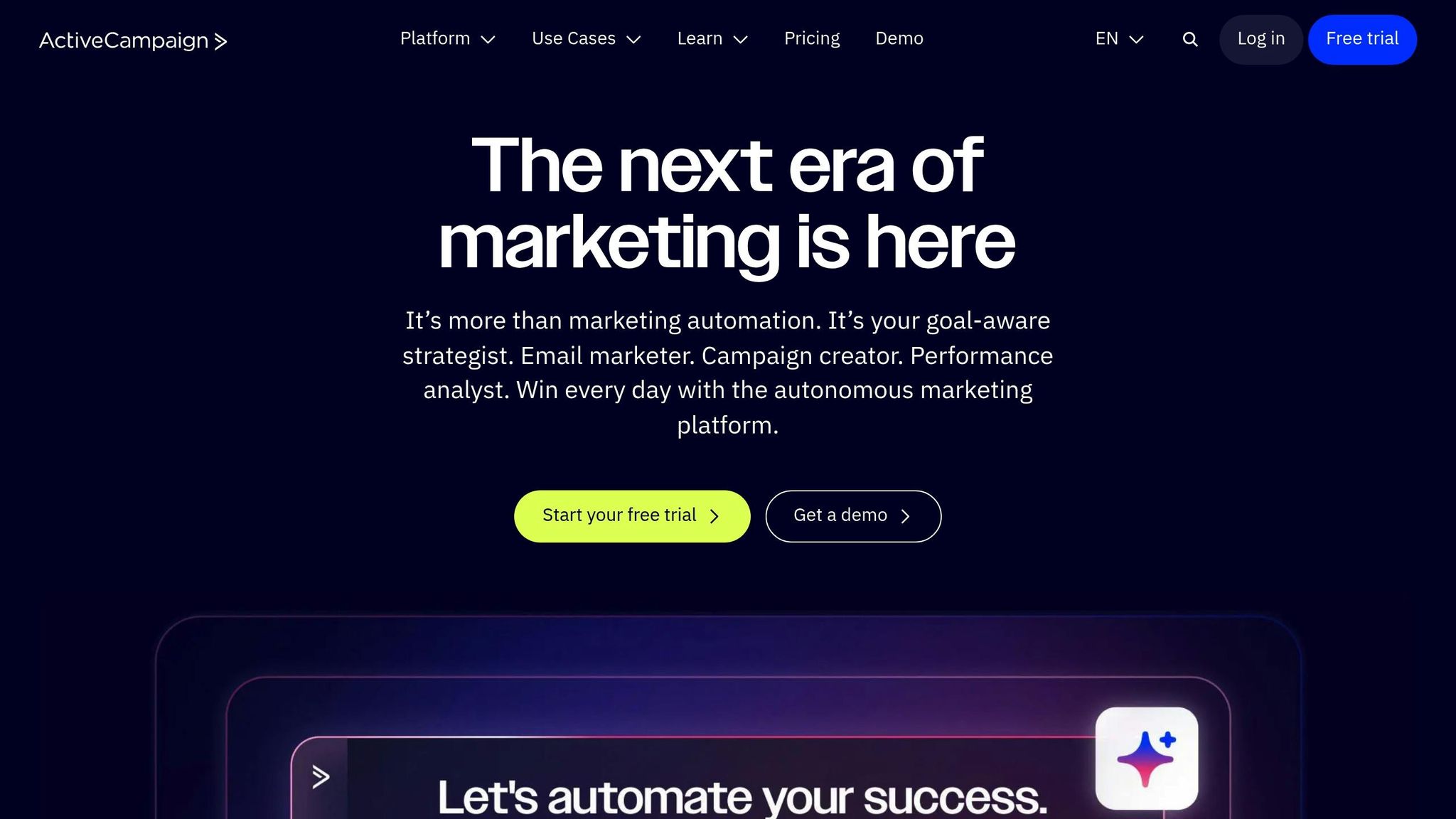
ActiveCampaign combines email marketing, automation, and CRM tools into one platform. Starting at $39/month for 1,000 subscribers with its Lite plan, it offers advanced features often reserved for pricier enterprise-level solutions. Its automation capabilities allow you to design personalized customer journeys based on user engagement, while machine learning optimizes send times and content for each subscriber. It also integrates seamlessly with platforms like Shopify, WordPress, and Salesforce, ensuring smooth data flow across your systems. With a 4.5/5 rating, ActiveCampaign delivers excellent value for its cost.
Mailchimp
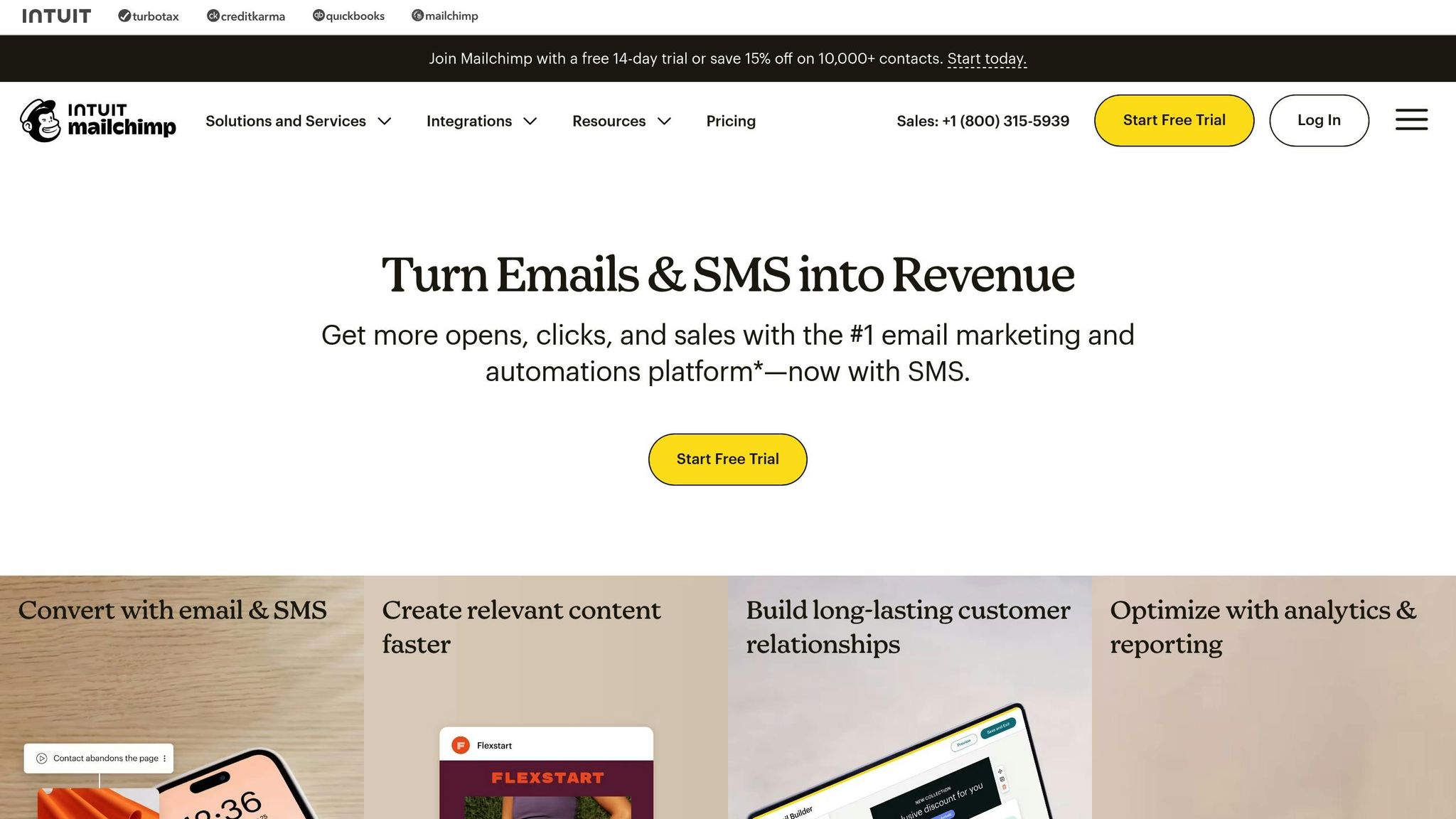
Mailchimp has grown into a full-fledged marketing suite with a variety of personalization tools. It provides a free tier for up to 500 contacts and 1,000 emails per month, with paid plans starting at $13/month for 500 contacts. Its drag-and-drop email builder makes it easy to create campaigns with dynamic content, and higher-tier plans include multivariate testing to refine subject lines, content, and timing. However, Mailchimp charges for unsubscribed and inactive contacts, and its automation features are less advanced compared to more specialized tools. Despite these limitations, Mailchimp holds a 3.8/5 rating.
Salesforce Marketing Cloud
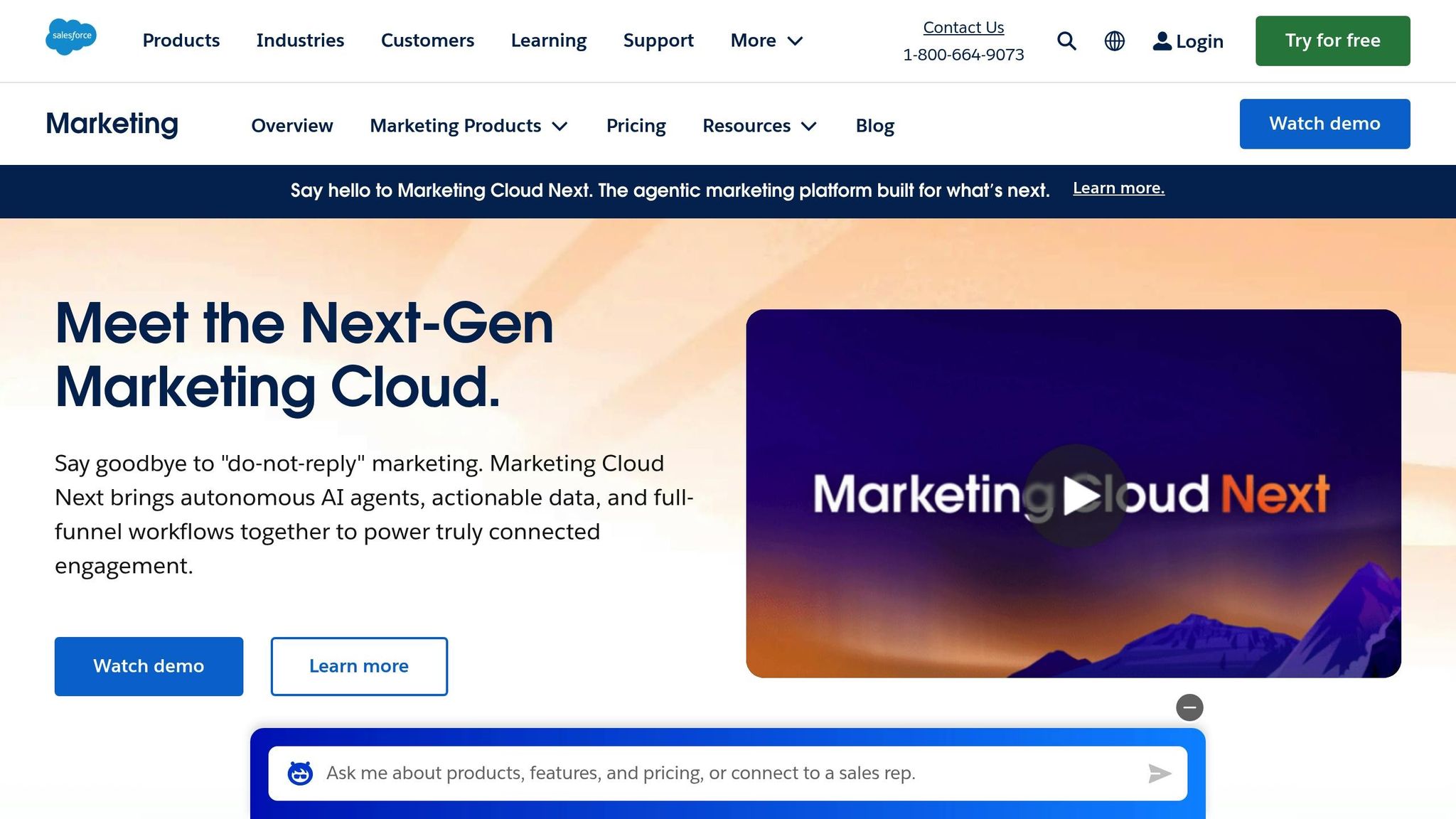
Salesforce Marketing Cloud is ideal for enterprises with complex personalization requirements. While pricing is not publicly available and requires consultation, the platform offers powerful features like Einstein AI to analyze customer behavior and Journey Builder for managing multi-channel campaigns. By unifying data from various sources into a single customer profile, it enables highly personalized cross-channel marketing. This makes it a strong contender for large-scale operations.
Insider
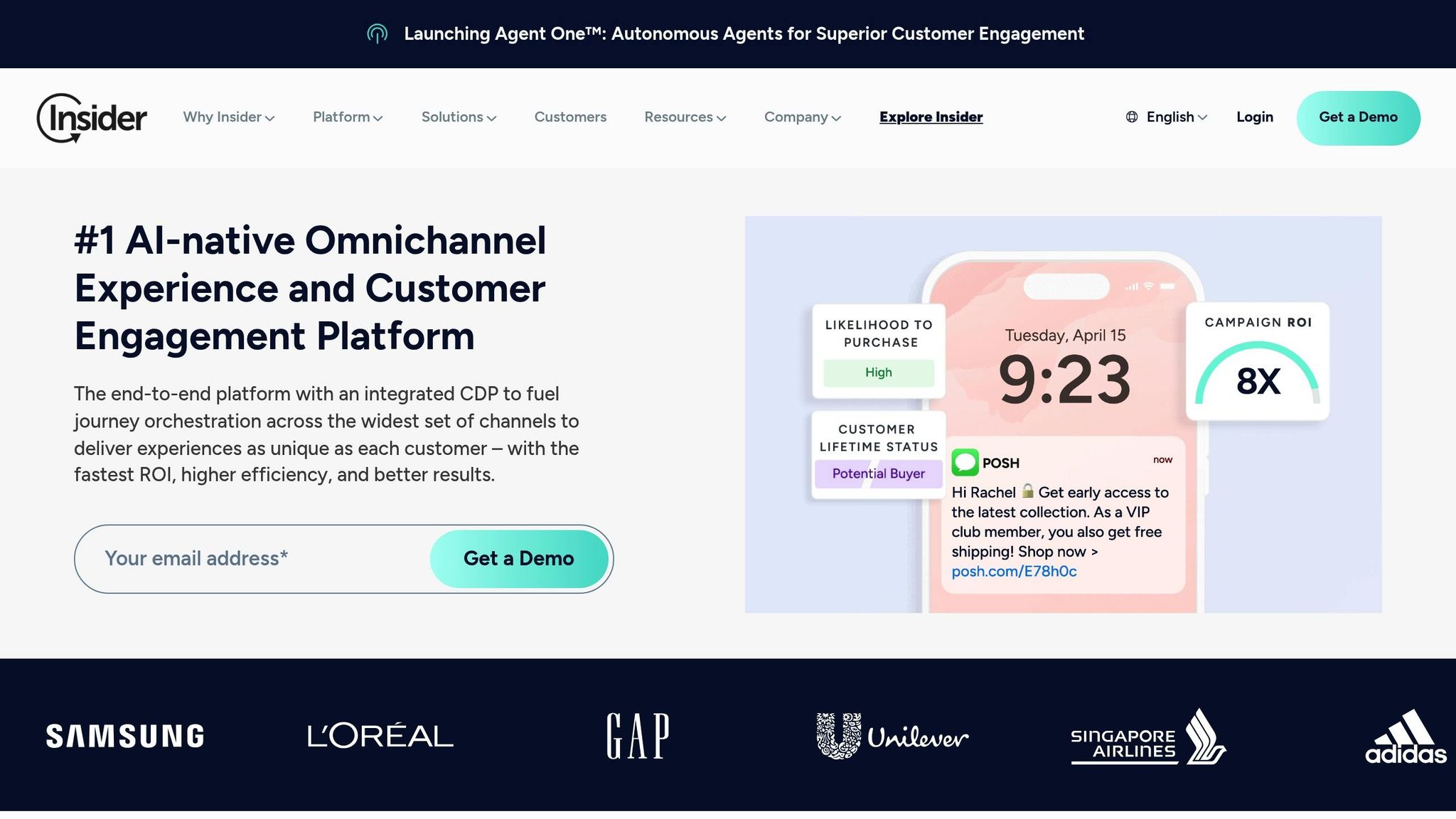
Insider specializes in AI-driven personalization for multi-channel campaigns, making it a great choice for e-commerce businesses. Its machine learning tools analyze customer behavior across channels, allowing you to create highly tailored campaigns. Pricing is custom-quoted, but many businesses report strong returns on investment thanks to its advanced personalization capabilities. Insider is particularly well-suited for businesses looking to elevate their e-commerce strategies.
Email Service Business Directory
For businesses wanting to streamline their search for personalization tools, the Email Service Business Directory is an invaluable resource. This directory provides side-by-side comparisons of platforms, offering detailed information on pricing, key features, integrations, user ratings, and performance metrics. With pricing options ranging from $299/month for budget-friendly plans to $2,999/month for enterprise solutions, the directory simplifies the process of finding a scalable tool that fits your needs. It’s a time-saving solution for businesses aiming to make informed decisions without extensive research.
How to Maximize ROI with Scalable Personalization
Getting the most out of your personalization strategy means using AI, smart audience segmentation, and seamless data integration to create impactful campaigns that deliver results without stretching your budget too thin.
Use AI and Automation
AI and automation take personalization to a whole new level, turning it into a high-return strategy. By automating tasks like creating personalized emails, analyzing customer data, and predicting behaviors, AI ensures campaigns hit the mark. For instance, AI-powered email automation can lead to up to a 25% boost in conversion rates, with 79% of companies reporting higher open rates.
Automated email campaigns are no small player in this arena - they deliver a 320% higher ROI compared to manual campaigns. In 2022, companies like Wix and Adobe saw AI-driven email marketing increase click-through rates by 13% and revenue by 41%.
"Creativity meets innovation and personalization takes center stage." - One marketer, Salesforce
AI doesn’t stop there. It also takes care of customer segmentation, lead scoring, product recommendations, and performance tracking. It can even generate personalized subject lines, email content, and product suggestions, all while monitoring key metrics and fine-tuning campaigns in real time.
Apply Advanced Audience Segmentation
Pairing AI with precise audience segmentation can elevate your campaign results even further. According to data, 24% of marketers rate email segmentation as the most effective tactic for improving performance. E-commerce businesses, for example, increased conversions from 1.31% for non-segmented campaigns to 1.79% with segmented campaigns.
"Email segmentation is the simplest way to ensure you're sending the right message to the right person at the right time. You don't need any technical skills to create segments of your audience, either. Most - if not all - ESPs will give you that feature out-of-the-box. The only thing you need to decide is what segments you want to create." - Jaina Mistry, Director, Brand and Content Marketing, Litmus
Segmentation can be based on factors like demographics, behavior, purchase history, email preferences, or location. For an even sharper edge, micro-segmentation hones in on highly specific behaviors and preferences, making emails feel uniquely tailored. Personalized emails, as a result, boast a conversion rate that’s 6x higher than non-personalized ones.
To make the most of this strategy, use dynamic content to customize email sections for each segment, craft subject lines that speak to their interests, and offer promotions that align with their traits. This targeted approach ensures your emails remain relevant and engaging, even at scale.
Connect with CRM and Analytics Systems
The final piece of the puzzle is integrating CRM and analytics systems to unify your personalization efforts. By feeding CRM data into email platforms, you can unlock advanced segmentation and trigger automated emails.
CRM data enables you to fine-tune product recommendations, create dynamic content, and offer localized deals tailored to your audience. For example, Warby Parker used predictive analytics and AI-driven segmentation to achieve a 25% increase in open rates, a 30% rise in click-through rates, and a 20% jump in conversions.
Another example comes from a financial services company that used AI to automate emails based on customer behavior and preferences. These automated emails accounted for just 2% of total email volume but drove 37% of all email-generated sales. By integrating CRM and analytics, you create a seamless data ecosystem that amplifies personalization efforts and drives impressive results.
Conclusion: Pick the Right Tools for Cost-Effective Personalization
When it comes to email marketing, the tools you choose can make or break your strategy. Platforms like ActiveCampaign, Mailchimp, Salesforce Marketing Cloud, Insider, and the Email Service Business Directory offer a blend of scalability, affordability, and advanced features that can deliver measurable outcomes. These tools are designed to integrate smoothly into your marketing efforts, helping you achieve your goals efficiently.
Personalized emails are a game-changer. They boost engagement and drive conversions, making it crucial to invest in the right tools now to secure long-term success. Start by defining your objectives, then explore free trials and demos to evaluate usability, automation capabilities, and analytics. Dive into user reviews and case studies to gain insights into real-world performance. For instance, ActiveCampaign holds a solid G2 rating of at least 4 out of 5 stars, highlighting its strong user satisfaction.
The Email Service Business Directory simplifies the selection process, offering a clear path to finding tools that fit your budget and needs. Whether you’re seeking entry-level automation for as little as $8.08 per month or enterprise-grade solutions, this resource eliminates the guesswork.
To future-proof your strategy, focus on tools that grow with your business. With 34% of email marketers already using AI for copywriting and over 90% reporting better engagement through segmentation, the right platforms can help you stay ahead of the curve.
Advanced features like AI-driven automation, detailed segmentation, and CRM integration are no longer optional - they’re essential for achieving meaningful results. By leveraging these strategies with the right tools, you’re setting your email marketing up to deliver strong ROI while keeping costs in check.
FAQs
How do AI-powered personalization tools enhance email marketing performance?
AI-driven personalization tools are transforming email marketing by crafting content that's customized for each recipient. This approach not only boosts engagement but also leads to higher conversion rates. By analyzing customer behavior and preferences, these tools make it possible to deliver tailored messages on a large scale - saving both time and money in the process.
On top of that, AI takes the guesswork out of campaign management. It automates key elements like send times, subject lines, and content optimization, ensuring your campaigns run more efficiently. The result? More impactful marketing efforts, improved ROI, and a smoother, more engaging experience for your audience.
What should I consider when selecting a personalization tool that works with my CRM system?
When selecting a personalization tool to pair with your CRM system, focus on compatibility to make sure it integrates smoothly with your current setup. Choose tools that are easy to navigate, adaptable, and flexible enough to meet your unique business requirements.
You’ll also want to assess how well the tool can boost your CRM strategy - specifically its ability to track customer journeys and facilitate meaningful communication. On top of that, dependable vendor support is essential for addressing any issues and getting the most out of the tool. By considering these factors, you can achieve personalized solutions that are both effective and aligned with your broader marketing objectives.
How does segmenting your audience improve personalized email campaigns?
Segmenting your audience lets you create more personalized email campaigns by organizing recipients into groups with similar characteristics - like demographics, behaviors, or preferences. This way, you can design messages that resonate with each group on a more individual level.
When your emails speak directly to your audience’s specific needs or interests, they’re more likely to catch their attention. The result? Higher open rates, increased engagement, and better overall campaign results. Plus, this kind of tailored communication builds trust and strengthens your connection with your audience.

